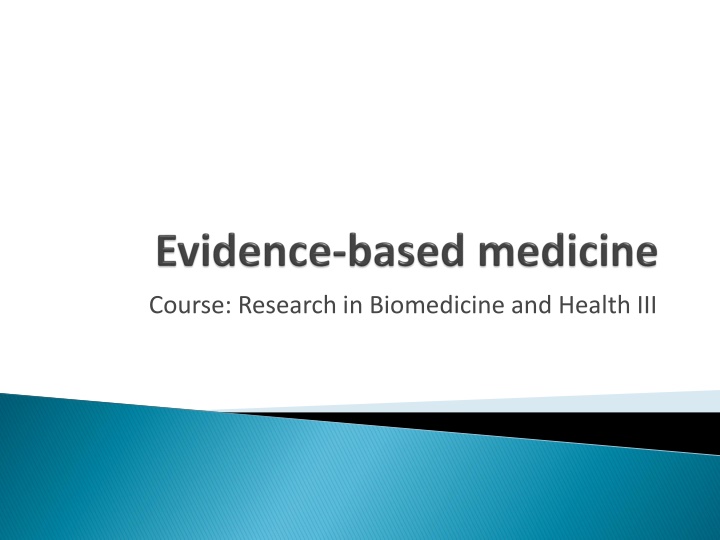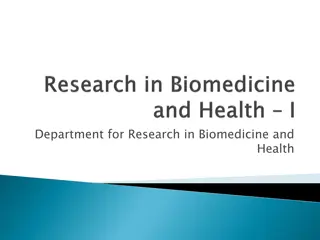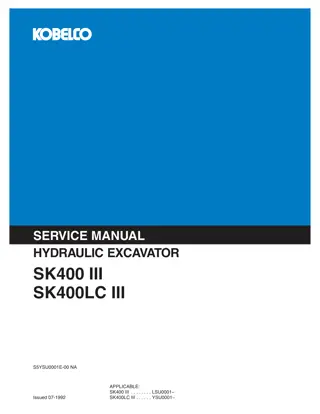Biomedicine and Health III Research Overview
This course delves into the process of research in biomedicine and health, covering steps such as formulating questions, finding evidence, and assessing effectiveness. Tools like SOPs, protocols, and guidelines are explored, along with varying study designs like RCTs, systematic reviews, and observational studies. The content also touches on different types of studies, study group formations, and outcome measurements. Causality, sample size considerations, duration, and pricing aspects are discussed in relation to study types.
Download Presentation

Please find below an Image/Link to download the presentation.
The content on the website is provided AS IS for your information and personal use only. It may not be sold, licensed, or shared on other websites without obtaining consent from the author.If you encounter any issues during the download, it is possible that the publisher has removed the file from their server.
You are allowed to download the files provided on this website for personal or commercial use, subject to the condition that they are used lawfully. All files are the property of their respective owners.
The content on the website is provided AS IS for your information and personal use only. It may not be sold, licensed, or shared on other websites without obtaining consent from the author.
E N D
Presentation Transcript
EBM steps Step 1: Formulating questions that can be answered Step 2: Finding best evidence Step 3: Quick critical assessment of the evidence Step 4: Applying evidence Step 5: Assessing effectiveness and efficiency of the process
EBM tools: - Standard operating procedures - Protocols - Guidelines - Algorhytms - Current best available evidence from literature
N of1 RCT Systematic review of RCTs (w or w/o metaanalysis) Individual RCT Systematic review of observational studies Individual observation study (cohort, case-conrol, cross-sectional study ) Physiological study Non-systematic clinical observations
All studies Q1 Descriptive Analytical Q2 Cross- sectional Descriptvie analytical Qualitative Experimental Q3 (Randomized) Paralel groups Cohort (Randomized) Cross-over groups Crosssectional analytical Q1- What is the aim of the study? Q2- Was the intervention randomized? Q3- When were the outcomes measured? Case- control
Time of study group formation Cross-sectional study Time of dana collection Case-control Experimental study Cohort Historical prospective cohort sada njost pro lost budu nost
Cross- sectional study Case-control Cohort Experimental Incidence/ Prevalence prevalence - incidencija incidencija Outcome >1 1 >1 >1 Causality No No Yes Yes Sample (N) big/small small big small/big Duration * ** *** *** Price * ** *** ****
Cross- sectional study Experimental study Case-control study Cohort study Incidence Apsolute and relative risk Incidence Apsolute and relative risk Prevalence Odds ratio Outcome reported Outcome (N) >1 1 >1 >1
Summaries of relevant literature that address a focused clinical question in which there are designs, methodologies and procedures that help reduce the likelihood of bias. Researchers who complete systematic reviews reduce bias by: - conducting a comprehensive search of relevant literature - using unambiguous inclusion and exclusion criteria for studies - summarizing findings using explicit statistical methodologies
minimize bias of the reviewer and in the research studies themselves enhance precision by including all the relevant evidence put results into context by examining conflicts and understanding differences help prioritize research by knowing exactly what has been done, how well, and with what findings
Quantitative synthesis Statistical analysis which pools results of two or more independent clinical trials, which can be combined according to the assessment of the analysts. Type of systematic review, where the choice of study design is usually restricted to a single type prospective randomized or cross-sectional) and their results are analyzed together, as a single study. The quality is directly related to the quality of included studies, and it enables the increase in statistical power, solution to contradicting results and correct assessment of treatment outcomes.
Example O Conner et al Medical Journal of Australia 2004; 180:128-130
Four treatments were tested against placebo in clinical trials for about 5 years. In no trial were there major side effects of the treatments. The results were reported as follows:
Trial A 91.8% in the group allocated to the active treatment survived, compared with 88.5% in the placebo group.
Trial A 91.8% in the group allocated to the active treatment survived, compared with 88.5% in the placebo group. Trial B Patients allocated to the active treatment had a 30% reduction in the risk of death.
Trial A 91.8% in the group allocated to the active treatment survived, compared with 88.5% in the placebo group. Trial B Patients allocated to the active treatment had a 30% reduction in the risk of death. Trial C Mortality was reduced by 3.3% in the group allocated to the active treatment.
Trial A 91.8% in the group allocated to the active treatment survived, compared with 88.5% in the placebo group. Trial B Patients allocated to the active treatment had a 30% reduction in the risk of death. Trial C Mortality was reduced by 3.3% in the group allocated to the active treatment. Trial D One death was avoided for every 30 patients treated.
Trial A 91.8% in the group allocated to the active treatment survived, compared with 88.5% in the placebo group. Trial B Patients allocated to the active treatment had a 30% reduction in the risk of death. Trial C Mortality was reduced by 3.3% in the group allocated to the active treatment. Trial D One death was avoided for every 30 patients treated. On the basis of these reports, and assuming all treatment costs are modest, which treatments would seem reasonable to introduce into your clinical practice?
Clinicians opinions: more than 70% considered the active treatments in Trials B and D worth using in clinical practice; Trial B: 30% reduction in the risk of death Trial D: 1 death avoided for every 30 patients treated less than 20% considered the treatments in Trials A and C worthwhile; Trial A: survival 91.8% vs. 88.5% Trial C: mortality reduced by 3.3%
The same trial: Trial A survival 91.8% vs. 88.5% EVENT RATE (EER and CER) Trial B 30% reduction in the risk of death RRR Trial C mortality reduced by 3.3% ARR Trial D 1 death avoided for every 30 patients treated NNT
Control Group Experimental group Event a b ER = event rate RR = risk reduction No event c d CER = a / (a + c) EER = b / (b + d) RRR = (CER EER) / CER ARR = CER EER NNT = 1 / ARR
Study results are often presented in a way that does not provide an intuitive understanding or the opportunity to quantitatively assess clinically relevant results to our patient. Answer: Statistical indicators for the assessment of different study designs.
1979 Bernard Lown (inventor of defibrillator) noticed that the most common cause of death in men aged 20-64 was heart attack. During heart attack, arrhythmia develops and is the cause of death. Lown suggested that a safe medication for arrhythmia with a lasting effect that protects from ventricular fibrillation would save millions of lives.
Researchers answered this call and found a chemical, flecainide a derivate of a local anesthetic which suppressed arrhythmia. Patients with a heart attack were randomized in groups with received flecainide or placebo. After some time, the groups reversed the treatment. Which type of study design this is?
Results 1 patient Paper published in New England Journal of Medicine (IF 48.49) Approved for use in the USA
Rationale: Flecainide decreases arrhythmia rate Arrhythmia causes heart attack (mechanism) Patients who had heart attack should be given flecainide Would you as a clinician give this medication to a 30-year-old man who survived 2 heart attacks?
Very soon after the first study, other researchers collected data on the survival of patients instead of the rate of paraventricular contractions. Survival of patients with flecaininde after 1 year was 2 x smaller from the controls!
Outcome designates whether the patient had or had no benefit from the provided care. Which outcome measure is a good indicator of efficacy? Should be clearly measured Should be easily defined Should be subject to standardization for research purposes
A patient presents to the clinic with a fresh dog bite. The bite site looks clean and the physician wonders if a prophylactic antibiotic should be administered. The physician searched PubMed and found a metaanalysis which claimed that the average infection rate after a dog bite was 14%, and that antibiotics halved this risk.
average infection rate after a dog bite was 14%. Antibiotics halved this risk.. Translated to outcomes: For each 100 people, antibiotic treatment will save 7 people from infection or Treating 14 people with a dog bite will prevent 1 case of infection. NNT number needed to treat : number of tpatients needed to be treated in order to prevent 1 unwanted outcome (infection, death .
Based on this information, the physician talks to the patient and they decide that antibiotic treatment would not be necessary.
Assessment of validity of results (are the observed differences random or not). Based on several key concepts (depending on study design) and simple calculations. The basis of each calculation is OUTCOME (survived or not, ill or not, recovered or not )
In cases where we want to assess the efficacy of an intervention taking medications or some other form of therapy (exercise, change in behaviour) we use statistical parameters.
Event Sum Present Absent Experimental group a b a + b (therapy) c d c + d Control group a + c b + d a+b+c+d Sum
Absolute risk reduction (ARR) ARR = risk of infection after dog bite without antibiotic treatment risk of infection after dog bite with antibiotic treatment 14% 7%=7% For each 100 people, antibiotic treatment will save 7 people from infection after a dog bite.
NNT (number needed to treat or number of patients who need to be treated in order to prevent 1 harmful event) NNT= total No. treated people /No. cured people 100/7=14 It is needed to treat 14 patients with a dog bite to prevent 1 case of infection.
Relative risk (RR) RR= ratio of risk of infection with antibiotics and risk of infection without infection =0.07/0.14=0.5 (50%) It is better to use ARR or NNT when talking to patients. It is more difficult to explain RR because it does not depend on the number of patients in the study.
relative risk reduction (RRR) RRR= 1- RR =1-0.5=0.5 (50%) Antibiotic therapy reduces the risk of infection by 50%.
Definition: NNT is the number of patients needed to be treated to prevent one harmful outcome. NNT is a reciprocal value of absolute risk reduction (1/ARR). NNT calculation: For appearance of disease/harm: 1 For improvement in health: 1 1 1 = = NNT= NNT= ARR CER EER ARR EER CER where CER control group event rate) EER experimental group event rate)
The results of the Diabetes Control and Complications Trial into the effect of intensive diabetes therapy on the development and progression of neuropathy indicated that neuropathy occurred in 9.6% of patients randomised to usual care and 2.8% of patients randomised to intensive therapy. The number of patients we need to treat with the intensive diabetes therapy to prevent one additional occurrence of neuropathy can be determined by calculating the absolute risk reduction as follows: ARR = CER EER= 9.6% 2.8% = 6.8% = 0.068 NNT = 1/ARR = 1/0.068= 14.7 15 We therefore need to treat 15 diabetic patients with intensive therapy to prevent one from developing neuropathy.
Calculate by yourself: In a randomised controlled trial looking into the long-term outcome for stroke patients treated in stroke units (SU) compared with patients treated in general wards (GW), the mortality rate 5 years after the onset of stroke was 59.1% in the patients treated in SU and 70.9% in those treated in the GW. How many patients need to be treated in stroke units to prevent one additional death?
P1 Cardiology In a RCT, patients with chronic heart failure were randomized into groups that underwent physical exercise programme or not. After 3.4 years, the mortality of the patients in the exercise group was 18.0%, and those without exercise 40.8%. Patients in the exercise programme had some heart problem in 34.0% cases, compared to 75.5% in the non-exercise group. Patients with exercise programme had 10.0% hospitalizations because of chronic hearth failure, in comparison to 28.6% in the control group. How many patients need to be included in the exercise programme to prevent an additional case for each of the measured outcomes.
P2 Dermatology In an RCT, the patients with an intravenouss catheter were randomized into the group that received a skin swab at the place of the catheter with chlorhexidine (0.5% chlorhexidine gluconate) or the group where the antiseptic swab was 70% isopropyl alcohol and then povidon iodide swab. In the chlorhexidine group, local infection after 72 hours developed in 1.2% of the patients, compared to 12.5% of the patients with standard antisepsis. How many patients need chlorhexidine antiseptic skin treatment to prevent one additional case of infection?
P3 Endocrinology Patients with diabetes requiring insulin therapy were randomized into two groups: 1) the patients were regularly telephoned by a specially trained nurse who advised them on the adjustment of insulin therapy and 2) the patients came to usual regular check ups at the endocrinologist s office. After 6 months, the percentage of patients who achieved at least a 10% decrease in HbAlc (glycolated hemoglobin) was 87% in the group contacted by the nurse, and 35% int he group that came for check-ups at the endocrinologist office. How many patients need to be in the telephone education programme to prevent one additional failure in diabetes control?
P4 Infectious diseases In a study of antiviral drug Acyclovir, patients with herpetic gingivostomatitis randomized to antiviral treatment had oral lesions after 8 days in 6.5% cases, problems with eating food in 6.5% cases and problems with liquid swallowing in 3.2% cases. In the control placebo group these percentages were 70%, 47% and 30%. How many patients should be treated with Acyclovir to prevent and additional case of each of the three relevant outcomes?
P5 Geriatrics In a study of preventing vertebral fractures in postmenopausal women with osteoporosis, the women randomly allocated to oral preparation of risedronate had 11% cases of new vertebral fractures after 3 years, compared to 16% in the placebo control group. The experimental group also had 5% cases of non-vertebral fractures, compared to 8% in the control group. How many patients need to be treated with risedronate to prevent one new case of new vertebral or non-vertebral fractures?
P6 Mental Health In a trial of treatments for the fear of flying, patients randomly assigned to the control group (wait-list control) the proportion of patients with improvement after 12 months (as measured by a questionnaire) was 7%. This proportion was 65% for patients on a standard therapy (8 sessions done at the airport with exposure to pre-flight stimuli and sitting on a stationary airplane with imaginal exposure to takeoffs, cruising and landing), and 53% in the group exposed to virtual reality (8 sessions, 4 of which involved information gathering, treatment planning, brief breathing training and cognitive restructuring). How many patients need to be treated to prevent one additional unwanted event for both therapies?
P7 Orthopedics In the study of lateral epicondylitis (tennis elbow), the patients randomized to the treatment by local injections of corticosteroids had 42% cases of full recovery after 4 weeks, compared to 5.7% in the group who received anti-inflammatory medication (enteric- coated naproxen). How many patients we need to treat with local corticosteroids to prevent one failed therapeutic outcome?
P8 Pulmology In a study of smoking cessation, the patients randomly assigned to the group receiving nicotine inhalators, the percent of abstinence after 1 year was 29%, compared to 18% in the group that did not receive the treatment. How many patients need to take nicotine inhalators in order to prevent one negative outcome of the smoking cessation therapy?























